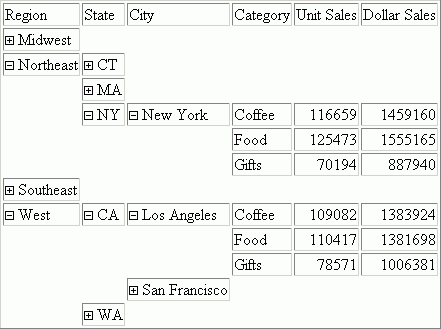Controlling the Display of Sorted Data With Accordion Reports
Accordion Reports provide a way to control the amount
of sorted data that appears on an HTML report page. You can produce
reports with expandable views for each vertical sort field in a
request with multiple BY fields.
You can create two types of Accordion
Reports:
Two vertical sort fields coded with BY phrases are required when
using Accordion Reports. If the command syntax does not contain
at least two BY phrases, the Accordion Reports EXPANDABLE or EXPANDBYROW
command is ignored, no message is generated, and a standard HTML
report is created.
Note: Accordion Reports are only supported for HTML report
output.
xRequirements for Accordion Reports
The following requirements must
be taken into consideration when creating Accordion Reports:
- Adding
a drill-down link to an Accordion Report requires that the TARGET
parameter must be set to a value that specifies a new HTML frame.
- Once an Accordion
Report is created and delivered to the user, there are no subsequent calls
to the WebFOCUS Reporting Server required when the user is interacting
with the report. However, the collapsible folder controls on the
sort fields require JavaScript and images that reside on the WebFOCUS
Client. The user must be connected to the WebFOCUS Web tier components
in order to use this feature. For online, connected users of WebFOCUS,
no change is required to the report.
However, for distribution
of reports using ReportCaster, see the following Reference topic
to ensure that the report is delivered correctly as an email attachment
or as an archived report in the Report Library.
x
Reference: Distributing Accordion Reports With ReportCaster
Distributing
Accordion Reports with ReportCaster requires the use of JavaScript
components and images located on the WebFOCUS Client. To access
the JavaScript components and images from a report distributed by
ReportCaster, the scheduled procedure must contain the SET FOCHTMLURL
command, which must be set to an absolute URL instead of the default
value. For example,
SET FOCHTMLURL = http://hostname[:port]/ibi_apps/ibi_html
where:
- hostname[:port]
- Is the host name and optional port number (specified only if
you are not using the default port number) where the WebFOCUS Web
application is deployed.
- ibi_apps/ibi_html
- ibi_apps is the site-customized web server alias pointing to
the WEBFOCUS80/ibi_apps directory (where ibi_apps is the default
value). ibi_html is a directory within the path to the JavaScript
files that are required to be accessible when viewing an Accordion
report
For more information about coding reports
for use with ReportCaster, see the Tips and Techniques for
Coding a ReportCaster Report appendix in the ReportCaster manual.
xCreating an Accordion By Row Report
Accordion By Row reports are HTML reports that offer
an interactive interface to data aggregated at multiple levels,
by presenting the sort fields within an expandable tree. By default,
the report will present the highest dimension or sort field (BY
value) and the aggregated measures associated with each value. The
tree control can be used to open or close each dimension and view
the associated aggregated values. Clicking the plus sign (+) next
to a sort field value opens new rows that display the next lower
level sort field values and subtotals. The lowest level sort field,
when expanded, displays the aggregated data values.
Using the SET EXPANDBYROW command and turning HTMLCSS ON enables
any HTML report to be turned into an Accordion By Row request. EXPANDBYROW
automatically invokes the SET SUBTOTALS=ABOVE command, which moves
the subtotal rows above the subheading and data rows. A SUB-TOTAL
command is automatically added for the next-to-last BY field.
When an Accordion By Row report uses the PRINT command, the innermost
level of the resulting tree contains detail records from the data
source. There can be many detail records for each combination of
BY fields, so it may be unclear what distinguishes the various detail
records within the display. In order to make the report more useful,
include at least one field in the report that can be used to distinguish
between the detail level rows.
When an Accordion By Row report uses the SUM command, each row,
even at the innermost level of the tree, is actually a subtotal
row and is completely described by the combination of BY fields
in the request. Each level will be presented at the aggregated level,
and the data values will represent the aggregation of the lowest
level BY.
Styling an Accordion By Row report can be done using standard
HTML report techniques, but it is important to keep the report structure
in mind. All rows, except the lowest level, are actually SUBTOTAL
rows and the lowest level contains the report DATA.
Accordion By Row reports display the grand total row as an anchor
row below the data. This anchor row displays above both the report
and page footings aligned to the left margin of the report. To generate
Accordion By Row reports without the grand total anchor row, add ON
TABLE NOTOTAL to the request.
Accordion reports can also be created to be opened by column,
instead of by row. See Creating an Accordion By Column Report for information
on how to create Accordion reports using the SET EXPANDABLE command.
x
Syntax: How to Create Accordion Reports That Expand By Row
SET EXPANDBYROW = {OFF|ON|n}ON TABLE SET EXPANDBYROW {OFF|ON|n}
where:
- OFF
-
Does not create an accordion report. OFF is the default value.
- ON
-
Creates an accordion report, which initially displays only
the highest sort field level. To see rows on lower levels, click
the plus sign (+) next to one of the displayed sort field values.
- ALL
-
Creates an accordion report in which all sort field levels
are initially expanded. To roll up a sort field level, click the
minus sign (-) next to one of the sort field values on that level.
-
n
-
Creates an accordion report in which n sort field
levels are initially expanded. To roll up an expanded sort field
level, click the minus sign (-) next to one of the sort field values on
that level.
Note:
- Accordion By Row
reports require that the HTMLCSS parameter be set to ON.
- By default, a blank
line is generated before a subtotal on the report output. You can eliminate
these automatic blank lines by issuing the SET DROPBLNKLINE=ON command.
Example: Creating an Accordion By Row SUM Report
The
following request against the GGSALES data source has four sort
fields, REGION, ST, CATEGORY, and PRODUCT:
TABLE FILE GGSALES
SUM DOLLARS/D8MC
UNITS/D8C
BUDDOLLARS/D8MC BUDUNITS/D8C
BY REGION
BY ST
BY CATEGORY
BY PRODUCT
ON TABLE SET HTMLCSS ON
ON TABLE SET EXPANDBYROW ON
ON TABLE SET DROPBLNKLINE ON
ON TABLE PCHOLD FORMAT HTML
ON TABLE SET STYLE *
TYPE=REPORT,
COLOR=RGB(66 70 73),
FONT='TREBUCHET MS',
SIZE=9,
SQUEEZE=ON,
GRID=OFF,
$
TYPE=REPORT,
GRID=OFF,
FONT='TREBUCHET MS',
COLOR=RGB(52 85 64),
$TYPE=TITLE,
COLOR='WHITE',
BACKCOLOR=RGB(52 85 64),
STYLE=-UNDERLINE,
$
TYPE=HEADING,
COLOR='WHITE',
BACKCOLOR=RGB(52 85 64),
$
TYPE=FOOTING,
COLOR='WHITE',
BACKCOLOR=RGB(52 85 64),
$
TYPE=SUBTOTAL,
BACKCOLOR=RGB(72 118 91),
$
TYPE=SUBTOTAL,
BY=1,
COLOR='WHITE',
$
TYPE=SUBTOTAL,
BY=2,
COLOR='WHITE',
BACKCOLOR=RGB(132 159 126),
$
TYPE=SUBTOTAL,
BY=3,
COLOR='WHITE',
BACKCOLOR=RGB(158 184 153),
$
TYPE=GRANDTOTAL,
COLOR='WHITE',
BACKCOLOR=RGB(52 85 64),
STYLE=BOLD,
$
ENDSTYLE
ENDThe initial output shows only the top level BY
field (REGION), as shown in the following image.

Clicking the plus
sign (+) next to the Midwest region opens the rows that show the
states associated with that region, as shown in the following image.
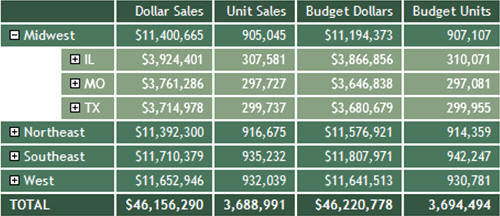
Clicking the plus
sign (+) next to the state IL opens the rows that show the categories associated
with that state, as shown in the following image.
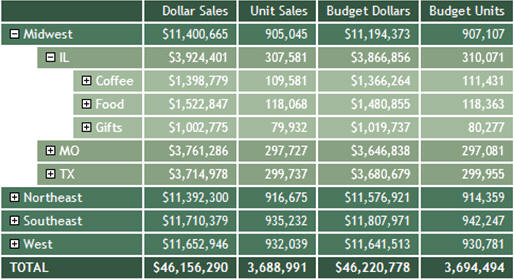
Clicking the plus
sign (+) next to the Coffee category shows the products associated
with that category, as shown in the following image. This is the
lowest level of the Accordion By Row report.
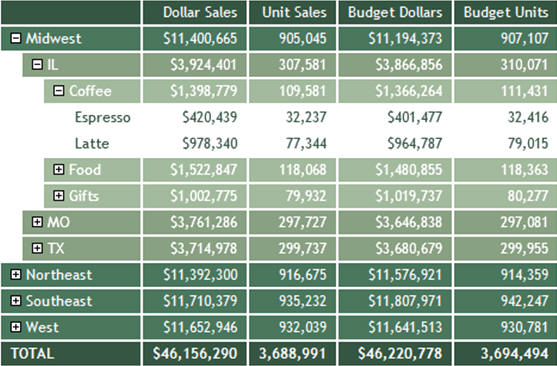
Example: Creating an Accordion By Row PRINT Report
The
following request against the EMPLOYEE data source has two sort
fields, DEPARTMENT and YEAR. It uses the PRINT display command.
SET EXPANDBYROW = ALL
DEFINE FILE EMPLOYEE
YEAR/YY = HIRE_DATE;
YEARMO/YYM = HIRE_DATE;
END
TABLE FILE EMPLOYEE
PRINT LAST_NAME AS 'Last,Name' FIRST_NAME AS 'First,Name'
CURR_SAL AS 'Current,Salary' ED_HRS AS 'Education,Hours'
BY DEPARTMENT BY YEAR
WHERE YEAR GT 1980
ON TABLE SET HTMLCSS ON
ON TABLE SET STYLE *
TYPE=REPORT,
COLOR=RGB(66 70 73),
FONT='TREBUCHET MS',
SIZE=9,
SQUEEZE=ON,
GRID=OFF,
$TYPE=TITLE,
BACKCOLOR=RGB(102 102 102),
COLOR=RGB(255 255 255),
STYLE=-UNDERLINE+BOLD,
$
TYPE=DATA,
BACKCOLOR=RGB(255 255 255),
$
TYPE=TITLE,
COLOR='WHITE',
BACKCOLOR=RGB(52 85 64),
STYLE=-UNDERLINE,
$
TYPE=HEADING,
COLOR='WHITE',
BACKCOLOR=RGB(52 85 64),
$
TYPE=FOOTING,
COLOR='WHITE',
BACKCOLOR=RGB(52 85 64),
$
TYPE=SUBTOTAL,
BACKCOLOR=RGB(72 118 91),
$
TYPE=SUBTOTAL,
BY=1,
COLOR='WHITE',
$
TYPE=SUBTOTAL,
BY=2,
COLOR='WHITE',
BACKCOLOR=RGB(132 159 126),
$
TYPE=SUBTOTAL,
BY=3,
COLOR='WHITE',
BACKCOLOR=RGB(158 184 153),
$
TYPE=GRANDTOTAL,
COLOR='WHITE',
BACKCOLOR=RGB(52 85 64),
STYLE=BOLD,
$
ENDSTYLE
ENDIncluding the fields LAST_NAME and FIRST_NAME
in the report output distinguishes each detail line. However, those
fields do not apply to the summary lines, so they are blank on the
summary lines.
The output is:
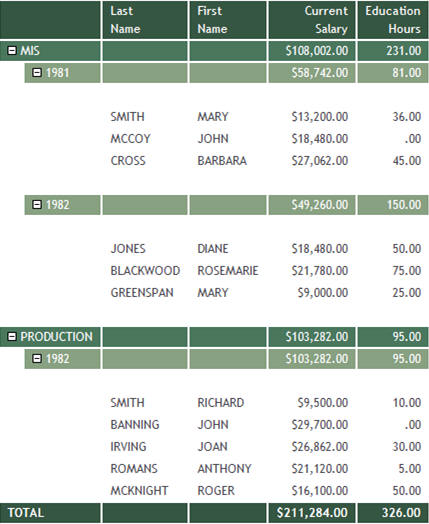
xAccordion By Row Tooltips
By default, EXPANDBYROW reports
display field information in tooltips activated when you hover the
mouse over the values at each level of the tree. Since the column
titles are not displayed above the tree control columns, as they
would be in a standard HTML report, the field list for the tree
is presented in the tooltip in the top-left corner of the report.
Pop-up field descriptions can also be enabled in Accordion By
Row reports to present the field descriptions maintained within
the Master File or DEFINE associated with the fields.
Titles can be customized by defining an AS name. To remove pop-up
field descriptions from the expanding tree, define a blank AS name
for the column title. In an Accordion By Row report, pop-up text
boxes that display on mouse over present additional information
about the fields and columns within the report. In standard Accordion
reports, these pop-up text boxes display the column title or AS
name for all of the BY values in the expandable tree.
As with standard HTML reports, the POPUPDESC parameter can be
set ON to display field descriptions in these pop-up text boxes
for all verb columns. Additionally, turning POPUPDESC ON will cause
the BY field pop-up text to present the description value, if available.
The table below represents the order of precedence for descriptions
displayed in tooltips when the EXPANDBYROW setting is on.
|
Existing Field Information
|
Pop-Up Description Off
|
Pop-Up Description On
|
|---|
|
Description
|
|
1
|
|
AS Name
|
1
|
2
|
|
Column Title
|
2
|
3
|
|
Field Name
|
3
|
4
|
The color and size presentation of the tooltips and pop-up descriptions
have been standardized for a uniform look throughout all reports.
Example: Creating an Accordion By Row Report Without Pop-Up Field Descriptions
The
following example demonstrates how pop-up text will display for
the standard Accordion report in the default presentation, which
means pop-up descriptions are not turned on.
DEFINE FILE GGSALES.
UNITS/D12C DESCRIPTION ''=UNITS;
TOTSALES/D12CM DESCRIPTION 'DOLLARS*UNITS'=DOLLARS*UNITS;
END
TABLE FILE GGSALES
SUM DOLLARS UNITS AS 'Units'
TOTSALES AS 'Total Sales'
BY REGION
BY CATEGORY AS ''
BY PRODUCT AS 'Product AS Name'
ON TABLE SET EXPANDBYROW ALL
ON TABLE SET DROPBLNKLINE ALL
ON TABLE SET STYLE *
TYPE=REPORT,
COLOR=RGB(66 70 73),
FONT='TREBUCHET MS',
SIZE=9,
SQUEEZE=ON,
GRID=OFF,
$
TYPE=TITLE,
BACKCOLOR=RGB(102 102 102),
COLOR=RGB(255 255 255),
STYLE=-UNDERLINE+BOLD,
$
TYPE=DATA,
BACKCOLOR=RGB(255 255 255),
$
TYPE=SUBTOTAL,
BACKCOLOR=RGB(200 200 200),
STYLE=BOLD,
$
TYPE=GRANDTOTAL,
BACKCOLOR=RGB(66 70 73),
COLOR=RGB(255 255 255),
STYLE=BOLD,
$
ENDFields as defined in the Master File:
FIELD=CATEGORY, ALIAS=E02, FORMAT=A11, INDEX=I, TITLE='Category',
DESC='Product category',$
FIELD=PRODUCT, ALIAS=E04, FORMAT=A16, TITLE='Product', DESC='Product name',$
FIELD=REGION, ALIAS=E05, FORMAT=A11, INDEX=I, TITLE='Region',
DESC='Region code',$
FIELD=UNITS, ALIAS=E10, FORMAT=I08, TITLE='Unit Sales',
DESC='Number of units sold',$
The following image
shows the pop-up description for the tree control, located at the
top-left corner of the table, displaying the list of column titles
or AS name for the given BY column within the underlying tree control.
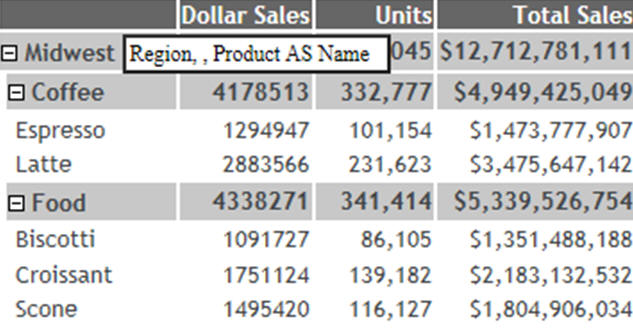
The
following image shows the pop-up text that will display when the
mouse hovers over any of the top level BY values that do not have
an AS name, but do have a defined description and title. In this
case, the column titles will display.

The
pop-up text for a top level BY value that has an AS name and a defined
description will display the AS name.

Example: Creating an Accordion By Row Report With Pop-Up Field Descriptions
The
following example demonstrates how pop-up text displays with pop-up
descriptions turned on.
SET POPUPDESC = ON
DEFINE FILE GGSALES.
UNITS/D12C DESCRIPTION ''=UNITS;
TOTSALES/D12CM DESCRIPTION 'DOLLARS*UNITS'=DOLLARS*UNITS;
END
TABLE FILE GGSALES
SUM DOLLARS UNITS AS 'Units'
TOTSALES AS 'Total Sales'
BY REGION
BY CATEGORY AS ''
BY PRODUCT AS 'Product AS Name'
ON TABLE SET EXPANDBYROW ALL
ON TABLE SET DROPBLNKLINE ALL
ON TABLE SET STYLE *
INCLUDE=ENDEFLT,$
END
As with all HTML reports, setting POPUPDESC=ON
will activate a text box that displays the field descriptions for
each of the verb column titles.

Additionally,
with POPUPDESC set ON, the field description will be presented for
the BY elements within the tree. If no field description is defined,
the column title or AS name will display.
With POPUPDESC=ON,
the defined description will display in the pop-up text, as shown
in the following image.

The
image that shows the description for the BY value appears in the
pop-up text even though an AS name has been given to this field.
For
additional information on pop-up field descriptions with HTML reports,
see Displaying Report Data.
xAccordion By Row With NOPRINT
Hidden, NOPRINT BY fields, can be used in Accordion
by Row reports. They allow the calculation of values for, and the
sorting of data by, fields which are hidden. NOPRINT sort fields
are included in the internal matrix and affect the sorting and aggregation
of data in the Accordion report, even though they are not displayed
in the report. These NOPRINT sort fields are defined using the BY sortfield NOPRINT
phrase.
Example: Creating an Accordion By Row Report With an Explicit NOPRINT
The
following request against the EMPLOYEE data source shows salary
data for employees, grouped in categories. The output is sorted
by the virtual field NAME_SORT, which concatenates the LAST_NAME
and FIRST_NAME fields. The NAME_SORT field is hidden using NOPRINT
on the sort phrase. To display employee names, the NAME_DISPLAY
virtual field is created, which concatenates the FIRST_NAME field
and the LAST_NAME field.
DEFINE FILE EMPLOYEE
NAME_SORT/A50=EMPLOYEE.EMPINFO.LAST_NAME || ( ', ' | EMPLOYEE.EMPINFO.FIRST_NAME );
NAME_DISPLAY/A57=EMPLOYEE.EMPINFO.FIRST_NAME | EMPLOYEE.EMPINFO.LAST_NAME;
NAME_CODE/A1=EDIT(LAST_NAME, '9');
NAME_GROUP/A10=IF NAME_CODE LE 'G' THEN 'A-G' ELSE IF NAME_CODE LE 'P'
THEN 'H-P' ELSE 'Q-Z';
END
TABLE FILE EMPLOYEE
SUM
EMPLOYEE.EMPINFO.CURR_SAL AS 'Current Salary'
BY NAME_GROUP AS 'Alphabetical Group'
BY LOWEST NAME_SORT NOPRINT
BY LOWEST NAME_DISPLAY AS 'Employee Name'
ON TABLE SET PAGE-NUM NOLEAD
ON TABLE SET EXPANDBYROW 2
ON TABLE PCHOLD FORMAT HTML
ON TABLE SET DROPBLNKLINE ON
ON TABLE SET HTMLCSS ON
ON TABLE SET STYLE *
TYPE=REPORT,
COLOR=RGB(66 70 73),
FONT='TREBUCHET MS',
SIZE=9,
SQUEEZE=ON,
GRID=OFF,
$TYPE=TITLE,
BACKCOLOR=RGB(102 102 102),
COLOR=RGB(255 255 255),
STYLE=-UNDERLINE+BOLD,
$
TYPE=DATA,
BACKCOLOR=RGB(255 255 255),
$
TYPE=SUBTOTAL
BY=1,
BACKCOLOR=RGB(200 200 200),
STYLE=BOLD,
$
TYPE=SUBTOTAL,
BY=2,
BACKCOLOR=RGB(200 220 220),
STYLE=BOLD,
$
TYPE=SUBTOTAL,
BY=3,
BACKCOLOR=RGB(220 220 200),
STYLE=BOLD,
$
TYPE=GRANDTOTAL,
BACKCOLOR=RGB(66 70 73),
COLOR=RGB(255 255 255),
STYLE=BOLD,
$
ENDIf you hover the mouse over any value in the NAME_DISPLAY
column, the tooltip will display the AS name, Employee Name, as
shown in the following image.
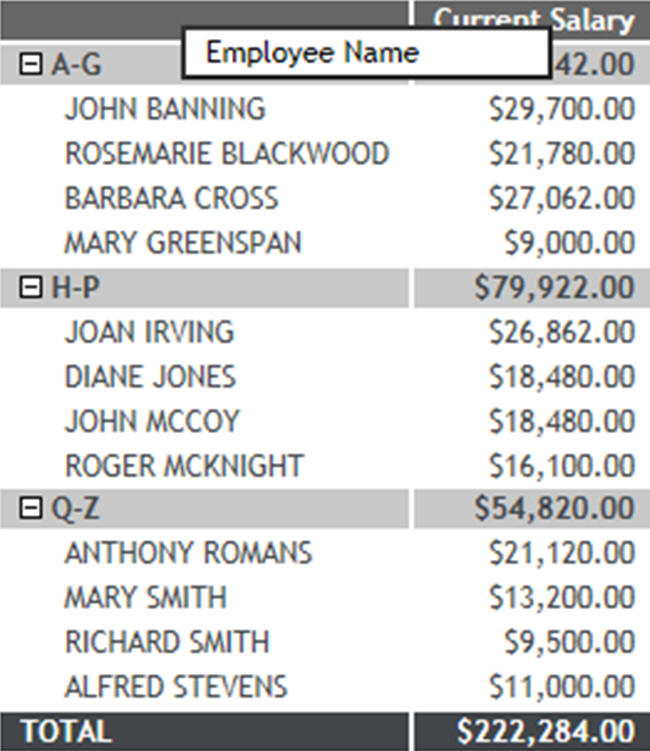
xDifferences Between Reformatted and Redefined BY Fields
When a sort field is dynamically reformatted, both the
original and reformatted fields are placed in the internal matrix.
The original field is not displayed, but is used to sort or aggregate
values.
When using a redefined field, the new column is used to display,
sort, or aggregate values.
Example: Creating an Accordion By Row Report With Dynamically Reformatted BY Fields
The
following request against the EMPLOYEE data source shows employees
and salaries by year of hire. The display fields, HIRE_DATE and
CURR_SAL, are sorted by HIRE_DATE reformatted with the format, YY,
and by the virtual field NAME_DISPLAY (employee name).
DEFINE FILE EMPLOYEE
NAME_SORT/A50=EMPLOYEE.EMPINFO.LAST_NAME || ( ', ' |
EMPLOYEE.EMPINFO.FIRST_NAME ); NAME_DISPLAY/A57=EMPLOYEE.EMPINFO.FIRST_NAME | EMPLOYEE.EMPINFO.LAST_NAME;NAME_CODE/A1=EDIT(LAST_NAME, '9'); NAME_GROUP/A10=IF NAME_CODE LE 'G'
THEN 'A-G' ELSE IF NAME_CODE LE 'P' THEN 'H-P' ELSE 'Q-Z';
END
TABLE FILE EMPLOYEE
SUM
HIRE_DATE
EMPLOYEE.EMPINFO.CURR_SAL
BY HIRE_DATE/YY
BY LOWEST NAME_DISPLAY AS 'Employee Name'
ON TABLE SET PAGE-NUM NOLEAD
WHERE HIRE_DATE LT '820101';
ON TABLE SET EXPANDBYROW ALL
ON TABLE PCHOLD FORMAT HTML
ON TABLE SET DROPBLNKLINE ON
ON TABLE SET HTMLCSS ON
ON TABLE SET STYLE *
INCLUDE=ENDEFLT,$
END
In the report generated, there are multiple expandable
groups or nodes for the same year, 1981. This occurs because the
reformatted values are used for display, but the original values
are still used for sorting and aggregating. In this report, 1981
is the common value used to represent two different dates, 81/07/01
and 81/11/02. The sorting takes place on the date, not on the year.
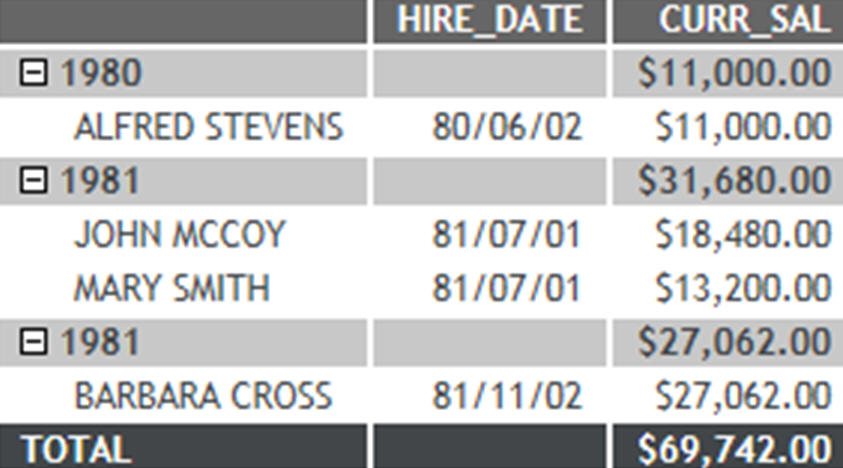
Example: Creating an Accordion By Row Report With Redefined BY Fields
To
sort your data on the reformatted field values instead of the original
field values, create a virtual field containing the BY value with
the new format applied. This will allow you to display, sort, and
aggregate on the new redefined BY value.
DEFINE FILE EMPLOYEE
NAME_SORT/A50=EMPLOYEE.EMPINFO.LAST_NAME || ( ', ' | EMPLOYEE.EMPINFO.FIRST_NAME );
NAME_DISPLAY/A57=EMPLOYEE.EMPINFO.FIRST_NAME | EMPLOYEE.EMPINFO.LAST_NAME;
NAME_CODE/A1=EDIT(LAST_NAME, '9');
NAME_GROUP/A10=IF NAME_CODE LE 'G' THEN 'A-G' ELSE IF NAME_CODE LE 'P'
THEN 'H-P' ELSE 'Q-Z';
DATE_HIRED/YY=HIRE_DATE;
END
TABLE FILE EMPLOYEE
SUM EMPLOYEE.EMPINFO.CURR_SAL
BY DATE_HIRED
BY LOWEST NAME_DISPLAY AS 'Employee Name'
ON TABLE SET PAGE-NUM NOLEAD
WHERE HIRE_DATE LT '820101';
ON TABLE SET EXPANDBYROW ALL
ON TABLE PCHOLD FORMAT HTML
ON TABLE SET DROPBLNKLINE ON
ON TABLE SET HTMLCSS ON
ON TABLE SET STYLE *
INCLUDE=ENDEFLT,$
END
In the above request, the verb fields, HIRE_DATE
and CURR_SAL are sorted by the DEFINE field, DATE_HIRED. The result
is a report sorted and aggregated by the redefined date values,
as shown in the following image.
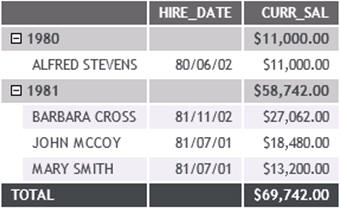
x
Reference: Usage for SET EXPANDBYROW
The
following features are not supported with Accordion By Row reports:
- TABLEF
- OVER
- ROW-TOTAL
- ON field RECAP
- FOR
- IN
- SEQUENCE
- PAGENUM
- SUBHEAD
- BORDER
- MULTILINES
- BY HIERARCHY
In
certain scenarios, a blank line is generated before a subtotal on
the report output. You can eliminate these automatic blank lines
by issuing the SET DROPBLNKLINE=ON command.
xCreating an Accordion By Column Report
Accordion By Column reports
do not automatically display entire report rows. A plus sign appears
to the left of each data value in the column under the highest-level
sort heading. For data associated with lower-level sort fields,
a plus sign is placed to the left of each data value, but the data
does not appear unless manually expanded. Data values of the lowest-level
sort field are not expandable. To expand your view of data for any
expandable sort field, click a plus sign and all data associated
with the next lower-level sort field appears. When you expand a
data value under the next to lowest sort heading, all of the remaining associated
data values in the report appear. This type of Accordion Report
is generated using the SET EXPANDABLE command.
x
Reference: Support for Accordion By Column Reports
The
following commands are not supported when using Accordion Reports:
BORDER, COLUMN, FOR, IN, OVER, PAGE-NUM, ROW-TOTAL, TOTAL
Data
Visualization, HTML BYTOC, OLAP, On Demand Paging (WebFOCUS Viewer),
column freezing, and the ReportCaster burst feature are also not
supported with Accordion Reports.
x
Syntax: How to Create Accordion by Column Reports
To
enable Accordion By Column Reports, specify the following
ON TABLE SET EXPANDABLE = {ON|OFF}where:
- ON
- Enables Accordion By Column Reports.
- OFF
- Disables Accordion By Column Reports. OFF is the default value.
Example: Creating an Accordion By Column Report
This
example shows how to use an EXPANDABLE command to create an Accordion
By Column Report.
TABLE FILE GGSALES
SUM UNITS DOLLARS
BY REGION BY ST BY CITY BY CATEGORY
ON TABLE SET EXPANDABLE ON
END
The following image shows an Accordion by Column
Report which displays all data associated with the first-level sort
field, Region, by default. The expanded data values you see are
the result of a report user clicking plus signs to the left of specific
first, second- and third-level sort fields after the report is generated.
